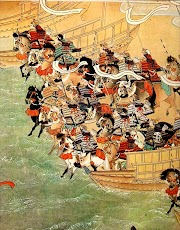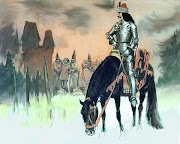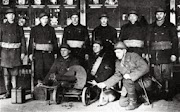The Utah War or the Mormon Rebellion as the US government viewed it was most certainly influenced by religion both was known and speculated about the Mormon religion and its followers from a US , Anglo-Christian tradition. Furthermore the Mormons dating back to their early history had a good reason to distrust and fear ‘Gentile’ rule. Mormons were not unaccustomed to prejudice and targeted violence throughout 1830s into 1850 and as result they had become militarized to certain extent before and after the Utah War. After Joseph Smith Jr. the Prophet and founder of the Church moved to Nauvoo , Illinois
The Legion in Illinois around 1844
The Nauvoo Legion was a Illinois state militia which was supplied and funded by Joseph Smith and the Church. Unlike other militias in just about every other state or territory the militia of Nauvoo was immaculately dressed in the best uniforms & outfitted with the best weapons & supplies that money could buy. The Legion attracted non-Mormons as well and grew to have 5,000 men or more in its ranks.
Relatively excellent (and perhaps shrewd) Mormon capital & financial skills would lead to subsequent economic prosperity for the Church when the LDS and its followers went West. In Illinois this prosperity was short lived following the arrest and subsequent murder of Smith and his brother by an anti-Mormon lynch mob. The death of the Prophet in Illinois 1844 was the precursor to this new type of LDS militarism centered on the Church-run militia under the overall command of either an elder member or the President of the Church himself. Historians have pointed to the Nauvoo Legion’s success as being partly to blame for Smith’s death and the Mormon exodus.
Joseph Smith reviewing the Nauvoo Legion.
An Interesting article about his sword and where it is today.
An Interesting article about his sword and where it is today.
This type of militia system was useful for defense in the Western territories because of the fears of Native American attacks and banditry. However this system showed its susceptibilities when war broke out between the American government and the Saints as they referred to themselves in the militias. Eventually the Nauvoo Legion was reestablished serving throughout the Utah War, as home guards during the Civil War, and then as Indian Fighters against the Navajo in the 1860's and 1870's.
Utah Nauvoo Legion circa 1865-1870
15th President of America at this time James Buchanan (b.1791-1868) ordered a military force eventually commanded by General Albert Sidney Johnston, known for his death fighting for the Confederacy at the Battle of Shiloh (TN) in 1862, to march on the Utah Territory in 1857 Deseret in the year 1849.
Map of the State Deseret imposed on the boundaries of the Utah Territory and the modern boundaries. (BYU)
Deseret never materialized and the Utah territory was established in 1850 after the LDS settled on the shores of the Great Salt Lake in 1847. This new Mormon ‘Zion ’ was under the control of Brigham Young with implied and almost unchecked Church control, despite being a territory of the Federal government and therefore subject to US government control.
This was certainly at the heart of the issue which led to the US-centric view that this was an armed revolt, like the Shays 1786-1787 or Whiskey rebellions of 1791-1794. Looking back we can draw parallels to the Utah War and the American Civil War; not in how this short and relatively bloodless war was fought but in why it was fought as David L. Bigler has done in his book The Mormon Rebellion: America's First Civil 1857-1858 (University of Oklahoma Press, 2011).
Albert Sidney Johnston shortly before his death in 1862 as the
commander of the Confederate Army in the West
Sherman L. Fleek, Professor and US Army, Retired, summarizes the start of hostilities as follows:
“The two main factors that caused the Utah War can best be summarized as, first, the differences in policies between federal and Church authorities concerning relations with the Utah Indians. The second consisted of Americans’ absolute fear of Mormon power and religious teachings, including practices such as polygamy, combined with the fear of perceived Mormon vigilantism and oppression of non-Mormons.”
Part of the Native American-Mormon-US conflict was played out in the controversial events even to this day of the Mountain Meadows Massacre in September 1857. What is discernible is that around 120 settlers in the Baker-Fancher party from
Massacre of the Baker-Fancher party, Mountain Meadows 1857
The Utah War developed into a war of sporadic skirmishing and small scale ambushes and raids. This benefited the very small number of Mormon forces who did actually exchange fire with the US army during the conflict, using some tactics resembling what we now refer to as guerrilla or insurgent warfare Casualties were low on both sides with almost every single US army casualty coming by way of exposure, disease & sickness, or accident. In fact many sources note that the Mormon militias were highly defensive and had orders to harass, chase off or steal the Federal horses and cattle to impend the march on Salt Lake City . In one case they ambushed a supply trained and burned many US army wagons and supplies in a undetected
lightning strike raid.
In the end not one pitched battle was fought from May 1857 to July 1858 as the US Army could not, and did not engage Mormon militiamen who they almost never saw or came in contact with. Johnston did eventually march on Salt Lake City peacefully establishing a fort outside the city after most of the Mormons had left the city. He allegedly remarked to one of his officers that he "would give up his plantation for a chance to bombard the city for 15 minutes." Despite mobilization the Mormons avoided conflict and wisely so; losing very few men or civilians without incurring the wrath of an occupying army who was openly defied. The militiamen who were relatively small in number yet still vastly outnumbering the occupying Army merely faded back into civilian life as farmers, traders, merchants, and church clergymen, or whatever their daily trade or profession was before the "war' had broken.lightning strike raid.
Brigham Young and the Church leaders claimed that no rebellion had taken place; mitigating at least some of the anti-Mormon rhetoric and fire-eaters in the Army and in Washington pushing for results and punishment for the Mormons after the conflict. This helped ensure a peace settlement with President Buchanan and made sure that the LDS would remain in power within the Federal governments’ territorial law. Young and his men were pardoned easing Utah's entrance to a status officially under Federal control.
Suggested Further Reading












